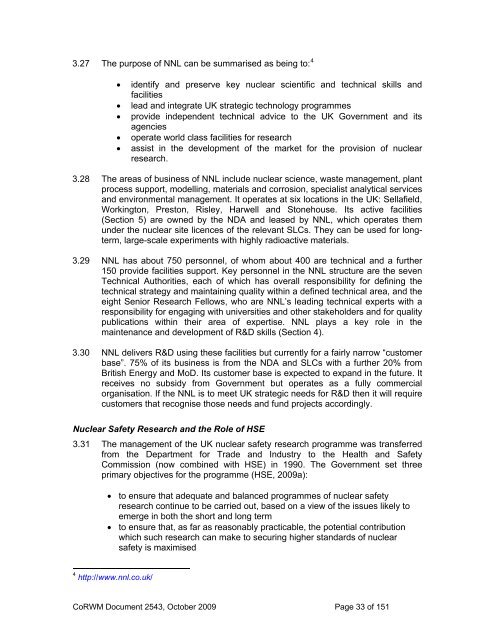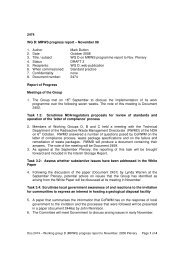2009 Report to Government on National Research and
2009 Report to Government on National Research and
2009 Report to Government on National Research and
- TAGS
- corwm.decc.gov.uk
Create successful ePaper yourself
Turn your PDF publications into a flip-book with our unique Google optimized e-Paper software.
3.27 The purpose of NNL can be summarised as being <str<strong>on</strong>g>to</str<strong>on</strong>g>: 4<br />
• identify <strong>and</strong> preserve key nuclear scientific <strong>and</strong> technical skills <strong>and</strong><br />
facilities<br />
• lead <strong>and</strong> integrate UK strategic technology programmes<br />
• provide independent technical advice <str<strong>on</strong>g>to</str<strong>on</strong>g> the UK <str<strong>on</strong>g>Government</str<strong>on</strong>g> <strong>and</strong> its<br />
agencies<br />
• operate world class facilities for research<br />
• assist in the development of the market for the provisi<strong>on</strong> of nuclear<br />
research.<br />
3.28 The areas of business of NNL include nuclear science, waste management, plant<br />
process support, modelling, materials <strong>and</strong> corrosi<strong>on</strong>, specialist analytical services<br />
<strong>and</strong> envir<strong>on</strong>mental management. It operates at six locati<strong>on</strong>s in the UK: Sellafield,<br />
Working<str<strong>on</strong>g>to</str<strong>on</strong>g>n, Pres<str<strong>on</strong>g>to</str<strong>on</strong>g>n, Risley, Harwell <strong>and</strong> S<str<strong>on</strong>g>to</str<strong>on</strong>g>nehouse. Its active facilities<br />
(Secti<strong>on</strong> 5) are owned by the NDA <strong>and</strong> leased by NNL, which operates them<br />
under the nuclear site licences of the relevant SLCs. They can be used for l<strong>on</strong>gterm,<br />
large-scale experiments with highly radioactive materials.<br />
3.29 NNL has about 750 pers<strong>on</strong>nel, of whom about 400 are technical <strong>and</strong> a further<br />
150 provide facilities support. Key pers<strong>on</strong>nel in the NNL structure are the seven<br />
Technical Authorities, each of which has overall resp<strong>on</strong>sibility for defining the<br />
technical strategy <strong>and</strong> maintaining quality within a defined technical area, <strong>and</strong> the<br />
eight Senior <strong>Research</strong> Fellows, who are NNL’s leading technical experts with a<br />
resp<strong>on</strong>sibility for engaging with universities <strong>and</strong> other stakeholders <strong>and</strong> for quality<br />
publicati<strong>on</strong>s within their area of expertise. NNL plays a key role in the<br />
maintenance <strong>and</strong> development of R&D skills (Secti<strong>on</strong> 4).<br />
3.30 NNL delivers R&D using these facilities but currently for a fairly narrow “cus<str<strong>on</strong>g>to</str<strong>on</strong>g>mer<br />
base”. 75% of its business is from the NDA <strong>and</strong> SLCs with a further 20% from<br />
British Energy <strong>and</strong> MoD. Its cus<str<strong>on</strong>g>to</str<strong>on</strong>g>mer base is expected <str<strong>on</strong>g>to</str<strong>on</strong>g> exp<strong>and</strong> in the future. It<br />
receives no subsidy from <str<strong>on</strong>g>Government</str<strong>on</strong>g> but operates as a fully commercial<br />
organisati<strong>on</strong>. If the NNL is <str<strong>on</strong>g>to</str<strong>on</strong>g> meet UK strategic needs for R&D then it will require<br />
cus<str<strong>on</strong>g>to</str<strong>on</strong>g>mers that recognise those needs <strong>and</strong> fund projects accordingly.<br />
Nuclear Safety <strong>Research</strong> <strong>and</strong> the Role of HSE<br />
3.31 The management of the UK nuclear safety research programme was transferred<br />
from the Department for Trade <strong>and</strong> Industry <str<strong>on</strong>g>to</str<strong>on</strong>g> the Health <strong>and</strong> Safety<br />
Commissi<strong>on</strong> (now combined with HSE) in 1990. The <str<strong>on</strong>g>Government</str<strong>on</strong>g> set three<br />
primary objectives for the programme (HSE, <str<strong>on</strong>g>2009</str<strong>on</strong>g>a):<br />
• <str<strong>on</strong>g>to</str<strong>on</strong>g> ensure that adequate <strong>and</strong> balanced programmes of nuclear safety<br />
research c<strong>on</strong>tinue <str<strong>on</strong>g>to</str<strong>on</strong>g> be carried out, based <strong>on</strong> a view of the issues likely <str<strong>on</strong>g>to</str<strong>on</strong>g><br />
emerge in both the short <strong>and</strong> l<strong>on</strong>g term<br />
• <str<strong>on</strong>g>to</str<strong>on</strong>g> ensure that, as far as reas<strong>on</strong>ably practicable, the potential c<strong>on</strong>tributi<strong>on</strong><br />
which such research can make <str<strong>on</strong>g>to</str<strong>on</strong>g> securing higher st<strong>and</strong>ards of nuclear<br />
safety is maximised<br />
4 http://www.nnl.co.uk/<br />
CoRWM Document 2543, Oc<str<strong>on</strong>g>to</str<strong>on</strong>g>ber <str<strong>on</strong>g>2009</str<strong>on</strong>g> Page 33 of 151



